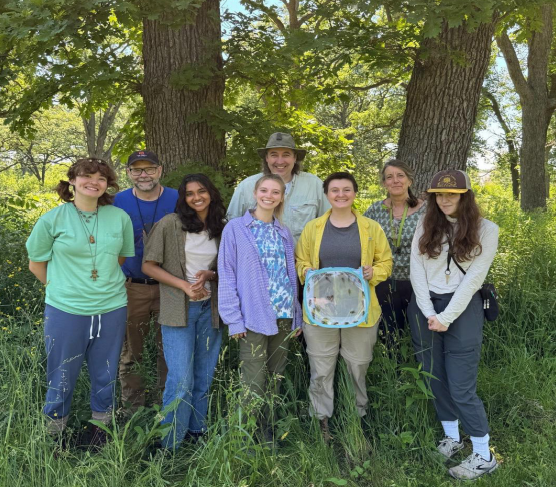Menke Lab: Decoding Ecosystems with Ants on the Frontlines
What is a once-in-a-lifetime opportunity? Is it the one time we see a shooting star? Meeting a favorite artist? Or a notable event where millions of insects emerge like something out of Pandora’s box? The latter came true for millions living in Illinois during the summer of 2024. Cicadas, which include annual and periodical species, emerged together—a rare event occurring once in 221 years. Annual cicadas emerge each year after 3-4 years of development underground, while periodical cicadas emerge as a group after 13 or 17 years underground. Periodical cicadas have evolved to overwhelm predators through sheer numbers. Millions of 13- and 17-year Cicadas emerge from the soil, live for 3-4 weeks, then die. Throughout their time underground, cicada nymphs feed on the sap of nearby plants and trees.
Unable to bite, sting, or fight, cicadas rely on their loud sound and sheer numbers for survival. Their collectively loud mating call, ranging from 20Hz to 12.8KHz, helps protect them from birds due to their sensitive hearing (Koenig et al., 2011; Shen, 2018). Cicadas can make such a loud noise, reaching up to 100 dB in dense populations, with the help of an anatomical structure called a tymbal (Noise & Team, 2021). Cicadas are prey to various animals, including birds, spiders, squirrels, humans, and ants. However, they still manage to overwhelm predators during their sudden and short emergence. They manage to climb trees to mate where females deposit their eggs deep in the trunks, protecting them from being eaten. When the eggs hatch, the sudden emergence of nymphs overwhelms predators again, allowing millions to burrow underground, starting their next 13- or 17-year cycle.
Studying the effects of Cicada emergence on ants is being conducted by the Menke Lab, led by Dr. Sean Menke, Chair and Professor of Biology at Lake Forest College (LFC). The Menke Lab focuses on how urbanization and biological invasions affect biodiversity and how climate and habitat restoration influence insect community structures. As a liberal arts institution, Lake Forest College encourages undergraduate involvement in research, and the Menke Lab offers short-term, hands-on projects suitable for undergraduate researchers. In addition to academic research, Prof. Menke also undertakes contract-based work for local organizations, including the Forest Preserves and the Chicago Botanic Garden, providing his expertise on ant populations. The Menke Lab gives students practical field experience studying ant populations and ecology.
Dr. Menke specializes in Community Ecology, Biogeography, Urban Ecology, and Myrmecology (the study of ants). His curiosity about the natural world led him to a deep fascination with ants. He received his Bachelor of Arts in 1999 from the University of Minnesota, Morris, where he majored in Biology with a minor in Geology. He researched the ecological effects of malformed frogs and completed an internship at the Smithsonian Institution on fish taxonomy. Dr. Menke continued his studies at the University of Oklahoma, earning a Master of Science in Zoology in 2002, focusing on lizard ecology in the Jornada del Muerto desert in New Mexico. Although he originally focused on reptiles, he shifted to studying ants during his PhD at the University of California, San Diego. His question-driven approach enabled him to transition seamlessly to studying ants, which allowed him to explore similar ecological questions. “The organism is a medium of research, not the reason,” said Prof. Menke. He completed his PhD in 2007 and subsequently pursued postdoctoral research at North Carolina State University from 2007 to 2010, where he focused on the effects of urbanization on ant populations. In Fall 2010, Prof. Menke began working at Lake Forest College and established the Menke Lab.
Recognizing the critical role ants play in ecosystems, the Menke Lab studies how invasive and native ant species serve as indicators of ecological health. As Prof. Menke says, “Without ants, we would be knee-deep in insects and other debris that ants help decompose and recycle.” This is particularly true during Cicada emergence, as millions of dead Cicadas must be cleared quickly.0000000000 For over a decade, the Menke Lab has studied the relationship between ants and the ecosystem, analyzing how Green Rooftops at the Chicago Botanic Garden support native ant populations, creating one of the longest longitudinal studies on this topic. The lab aims to identify patterns in ant species and populations across seasons and compare them with those found below the Green Rooftops. While this study is ongoing, the Menke Lab began preparing for a new project in Summer 2023, capturing baseline measurements of ants and the ecosystem in anticipation of the 17-year Cicada emergence in 2024.
The Cicada emergence of summer 2024 is noteworthy because two broods (13-year and 17-year) emerged together but never overlapped geographically. The 17-year Brood XIII emerges only in Northern Illinois, while the 13-year Brood XIX emerges in Southern Illinois. Fig. 1 illustrates the Illinois map with the locations of Brood XIII, XIX, and XXIII (17-year) (Simon et al., 2022). Prior to establishing baseline measurements, the Menke Lab set up a 3-year collaboration with two Professors: Dr. John Lill, Professor of Biology at George Washington University, DC and Dr. Martha Weiss, Professor of Biology at Georgetown University, DC. They hope to examine the effects of Cicadas on terrestrial ecosystems, while the Menke Lab is particularly interested in examining ants’ behavior in a period of enhanced resource availability during the cicada emergence.

Figure 1. 1 Illustration of an Illinois map with the locations of Brood XIII (17-year), XIX (13-year), and XXIII (17-year) (Simon et al, 2022).
Given the limited data collection period, the lab maximized experiments with 8 individuals working full-time throughout the summer (Figure 2). The types of studies included monitoring predation rates on both dead and freshly killed Cicadas, how quickly ants find and consume them, which species are involved, and how removal rates compare to other insects like fruit flies. Seed removal rates were also tracked for plants that are mutualists with ants. On a broader scale, they measured the foraging patterns and the location, such as on trees or the ground, and observed whether ants’ food preferences changed over time.

Figure 2. Menke Lab and collaborators in the field, left to right, Ms. Kiera McKee ’27 (LFC), Dr. John Lill (George Washington University), Ms. Saniya Varghese ’27 (LFC), Ms. Mia Pitcock ‘25 (George Washington University), Dr. Sean Menke (LFC), Ms. Calliope Saban ’25 (LFC), Dr. Martha Weiss (Georgetown University), and Charlotte Cleveland ’25 (LFC).
These questions will be addressed by analyzing the extensive data collected in summer ‘23, ‘24, and post-Cicada data from summer ‘25 and ‘26. 17-year Cicadas include three species from the Genus Magicicada, M. septendecim, M. cassini, and M. septendecula. Menke lab worked with all three species during the summer ’24. The data collection and analysis will provide invaluable research experience for the next generation of ecologists. If you are interested in working with ants and participating in fieldwork, contact Dr. Menke (menke@lakeforest.edu) to inquire. You can join the 3-year Cicada project or other ongoing research such as examining carbon isotopes shifts in ants.
Two years ago, Cicadas and their interaction with ants were new to Prof. Menke. His philosophy of always being open to changes and being question-driven made him realize that there are several mediums of answering the same question.ig, W. D., Ries, L., Olsen, V. B. K., & Liebhold, A. M. (2011). Avian predators are less abundant during periodical cicada emergences, but why? Ecology, 92(3), 784–790. Noise, N., & Team, B.-A. (2021, July 20). Noise myths debunked – fact and fiction behind all the cicada buzz. Centers for Disease Control and Prevention. Cicadas. (2024). Illinois Extension. Simon, C., Cooley, J. R., Karban, R., & Sota, T. (2022). Advances in the Evolution and Ecology of 13- and 17-Year Periodical Cicadas. Annual Review of Entomology, 67(1), 457–482. Shen, L. (2018). “Summer is watermelons, rainstorms, mosquitoes, burning sunshine and air conditioning. but a summer is not a summer without the chirping of cicadas.” HBK World.
Note: Eukaryon is published by students at Lake Forest College, who are solely responsible for its content. The views expressed in Eukaryon do not necessarily reflect those of the College. Articles published within Eukaryon should not be cited in bibliographies. Material contained herein should be treated as personal communication and should be cited as such only with the consent of the author.
References
Koenig, W. D., Ries, L., Olsen, V. B. K., & Liebhold, A. M. (2011). Avian predators are less abundant during periodical cicada emergences, but why? Ecology, 92(3), 784–790.
Noise, N., & Team, B.-A. (2021, July 20). Noise myths debunked – fact and fiction behind all the cicada buzz. Centers for Disease Control and Prevention.
Cicadas. (2024). Illinois Extension.
Simon, C., Cooley, J. R., Karban, R., & Sota, T. (2022). Advances in the Evolution and Ecology of 13- and 17-Year Periodical Cicadas. Annual Review of Entomology, 67(1), 457–482.
Shen, L. (2018). “Summer is watermelons, rainstorms, mosquitoes, burning sunshine and air conditioning. but a summer is not a summer without the chirping of cicadas.” HBK World.

